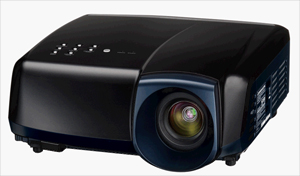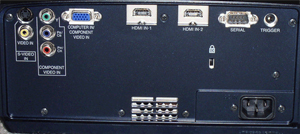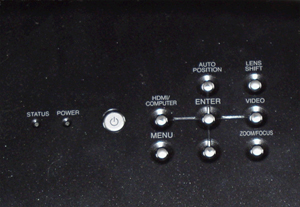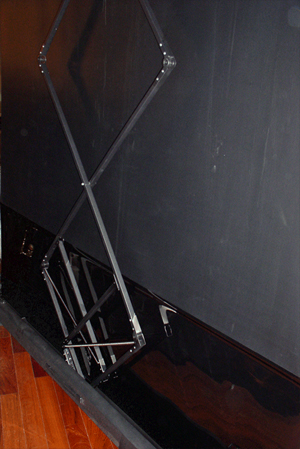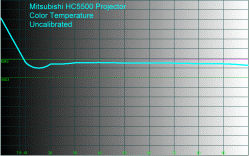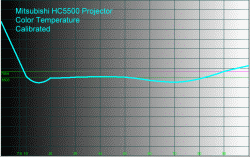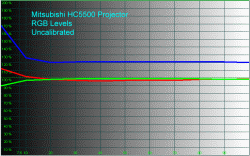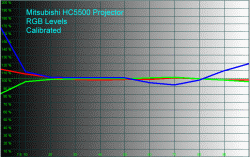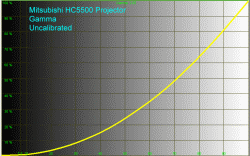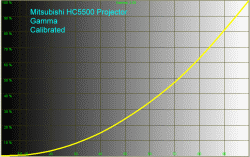Introduction
I am continuing my journey into the world of affordable front projector systems, with a special emphasis on systems that are suitable for multi-use rooms. My first foray, the Sanyo PLV-Z2000, was a success. But I didn’t have anything to compare it to, at least in my own home environment. Now comes the first challenger, the Mitsubishi HC5500, another affordable 1080p projector. These projectors use the same basic display technology (LCD panels), so provide a pretty good apples-to-apples comparison.
Since the goal of the series is a relatively painless and economical way to set up a front projector system in a non-dedicated room, this installment also includes a look at the other end of the picture, the screen. While I’ve seen motorized, curved and acoustically perforated screens at trade shows and in dedicated home theaters, they are quite expensive. The average person buying an entry-level projector is unlikely to spend as much on the screen as they did on the projector. Plus, a permanently installed screen taking up an entire wall of a non-dedicated room is unlikely to pass the Spousal Approval test.
To address those needs, there is an entire market segment of drop-down screens, both ceiling and wall-mounted. My family room has cathedral ceilings, so a ceiling mounted screen isn’t an option. And because my current main display is a rear-projection TV, a wall-mounted screen won’t work either, unless I build a soffet to extend out beyond the front of my RPTV (RPTV’s, using DLP or LCOS technology, are typically around 14 inches deep). So I decided to keep it simple, and started with a pull-up portable screen, the Elite ezCinema Plus.
The Projector: Mitsubishi HC5500
The HC5500, which replaces Mitsubishi’s HC 4900 projector, lists for $4,995 but street pricing is around $2,495 (NOTE: Mitsubishi also offers a $500 mail-in rebate through December 31, 2008). The 5500 uses three LCD inorganic panels, with a native resolution of 1920 x 1080 pixels. The 5500 has both motorized zoom and focus controls, quite useful if the projector is mounted in a location that is not readily accessible. The other side of the coin is that the HC 5500 has extremely limited placement options. The zoom range is only 1.2x, and vertical lens shift is limited to 2.0 screen heights. There is no horizontal lens shift. So you need to carefully calculate your room and screen size to determine the proper placement of the projector.
Specifications
- Design: LCD Projector
- Native Resolution: 1920 x 1080
- Brightness: 1200 ANSI Lumens
- Contrast Ratio: 14,000:1 (Full On/Off)
- Dimensions: 4.9″ H x 13.1″ W x 13.9″ D
- Weight: 12.3 Pounds
- MSRP: $1,995 (after $500 mail-in rebate)
- Available from Projector People at Discount Price
- Mitsubishi
Design and Setup
The HC 5500 is compatible for use with an anamorphic lens, which uses the full panels for projecting 2.35 film material. Anamorphic lens are expensive, and also require a room capable of projecting the extra-wide image. The Mitsubishi’s scaler allows the user to keep the anamorphic lens in place, even when not watching 2.35 material. I don’t know how many consumers will choose to mate an entry-level projector with an anamorphic lens, but the HC 5500 is a way to test the waters without breaking the bank.
The Mitsubishi comes in bat-cave black, which tends to blend in better in a dedicated theater than multi-use rooms with white ceilings. The HC 5500 has two HDMI inputs (v. 1.3), plus one VGA, component, S-video and composite inputs, all on the rear panel. The top panel has menu controls mirroring the function of the remote control. The back-lit remote allows the user to switch between three memorized pre-sets, and adjust zoom and focus in both fast and single-step increments.
The Mitsubishi uses the Silicon Optics Reon-VX HQV processing chip for upconverting and deinterlacing non-1080p content. The HC 5500 can also display 1080p/24 frames-per-second. The HC 5500 has four pre-set gamma modes: Auto, Sports (bright mode for watching sports in ambient light), Video, and Cinema (for dark rooms). There are also two user-adjustable gamma curve settings. Beside the three usual brightness modes (Cool, Medium and Warm), you can manually adjust the R, G and B contrast and brightness settings within each pre-set. It also has an auto-iris, which dynamically increases light output for maximum black level. For most of my viewing, I used the Medium setting, which is supposed to approximate the reference 6500K color temperature. The HC 5500 allows the user to set and store three separate image quality settings for each input source, which can be called up from the remote control.
Placement of the HC5500 was a little tricky. I am using an 84” diagonal screen (73” horizontal), because anything wider would cover my left and right main speakers. Due to the Mitsubishi’s limited zoom ratio, I could not place the projector on a coffee table in front of the couch. Instead, I mounted the projector on a portable table behind the main seating position, which still only put it about 10.5 feet from the screen. While that was fine for wide-screen movies, I found it a little fatiguing while watching 16:9 HDTV images for extended periods. On the plus side, the Mitsubishi is very quiet, so fan noise was not an issue.
The Screen: Elite Screens ezCinema Plus Portable Screen
The Elite Screens ezCinema Plus is a portable, pull-up screen designed for traveling presentations or portable home theater applications. The Cinema Plus series uses a spring scissor mechanism for lifting the screen, rather than a telescoping pole found in the regular ezCinema series.
The ezCinema Plus comes in various sizes; in a 16:9 configuration up to 100” diagonal inches. The screens are available in white (1.1 gain) or grey (1.0) material, with ¾” black top/side masking. The bottom masking is adjustable, depending on how high you lift the screen material out of its housing. The 84” screen is available for $389.99.
Specifications
- Design: Manual Pull-up Projection Screen
- Material: MaxWhite, 1.1 gain
- Screen Size: 84″ Diagonal
- Dimensions: 80″ H x 71.2″ W
- Weight: 22.3 Pounds
- MSRP: $389.99 USA
- Elite Screens
Setting up the screen is really easy: first pivot the two rotating feet 90 degrees for stability, flip up the latches, then open the lid and pull up on the screen handle. The screen lifts up easily, without bunching or balkiness, and stays put when you let go of the handle (no locking required). I did not notice any folds, wrinkles, or waves on the screen. Storing the screen simply involves reversing the above-process, which takes less than minute from start to finish. I left the screen in front of the RPTV when not in use. This is really a no-hassle, spouse-friendly way to have a projection screen in the room without installation hassles.
In Use
I fed the HC5500 a variety of program material, including DVD sourced from my Oppo DV-980H player, and high-definition material from both disc and cable TV. My subjective impression was that the Mitsubishi put out a somewhat brighter image that the Sanyo PLV-Z2000, but with slightly less detail than the Sanyo. I would guess that is a function of ANSI contrast.
Batman Begins is a popular demo disc, especially the training scene with Liam Neeson and Christian Bale fencing on a sheet of thin, cracking ice. The Mitsubishi’s image was quite bright, with colors that seemed reasonably life-like (although it seemed slightly oversaturated with user-level calibration). Television HD (1080i) was deinterlaced by the Mitsubishi without obvious artifacts, and programming that lacked quick panning action (like The Late Show with David Letterman) looked especially sharp. NFL football in HD had occasional problems with fast-moving images, but this is more an issue with LCD technology in general than anything specific to the HC5500. Overall, the HC5500 put out a bright, pleasing image similar to that of the Sanyo.
The Elite ezCinema Plus screen was a real treat, taking nothing away from the picture. Off-axis viewing was very good, with no obvious hot-spotting or loss of contrast. Despite lifting and lowering the screen many times over the review period, it never showed signs of wrinkling or uneven, wavy surfaces. The Elite Screens ezCinema Plus screen is a wonderful solution for those interested in front projection, but either cannot or don’t want to permanently install a ceiling or wall-mounted screen.
On the Bench
Uncalibrated, the color temperature was on the hot side (too blue). After calibration, the overall temperature was closer to D6500.
The uncalibrated RGB levels indicated red and green in the right place, but blue was far too high (the graph is an indication of gray scale tracking, i.e., whether the image stays white at all IRE levels or has specific tints at various IRE). After calibration, blue was closer to where it should be, but unfortunately, red and green were not nearly so smooth as they were in the uncalibrated state. Calibration of one item often affects others. The HC5500’s color controls are limited.
Gamma before and after calibration were insignificantly different (2.05 and 2.08 respectively).
There is plenty of brightness with this projector, so it works well in semi-darkened rooms. The contrast, on the other hand, is not very good. ANSI CR was 270:1, and the Full On/Off CR was less than 1000. I did not activate the Dynamic Iris for the measurements, because the iris does not generate true contrast. The iris simply makes dark scenes look better by closing down and producing less brightness so you won’t see the leakage in the dark areas of the scene. But this also makes the lightest areas darker. We can call this inter-frame contrast, because it measures the contrast between the dark areas of a dark scene frame that is shown with the iris closed down, and the light areas in another frame in a different scene that does not have dark areas, so the iris remains open. True contrast is measured within a single frame, between the lightest areas and darkest areas. Maximum contrast cability would be found within a single frame that has regions at 0 IRE and regions at 100 IRE, which takes into account not only light leakage, but the flare properties of the lens. We use the ANSI test pattern for this. Full On/Off contrast is also measured, but it is rare that a movie scene frame is totally black (0 IRE) or totally white (100 IRE).
I think the low contrast may be because Mitsubishi has to use lower cost LCD panels to keep the price down, and they simply cannot stop leakage through the panels with such a high output bulb. This leakage is seen in dark areas of a movie scene and also in the 0 IRE test pattern. Nevertheless, the image was pleasing and satisfactory.
Conclusions
The Mitsubishi HC5500 is another good, value-priced 1080p front projector. Compared to the Sanyo PLZ-2000, it has certain attributes that make it a more attractive option for those interested in a permanent installation, such as anamorphic lens compatibility and motorized zoom and focus. On the other hand, the Mitsubishi’s limited placement options mean that for consumers interested in maximum flexibility, they should carefully consider whether the HC5500 is appropriate given their room and screen size preferences.



